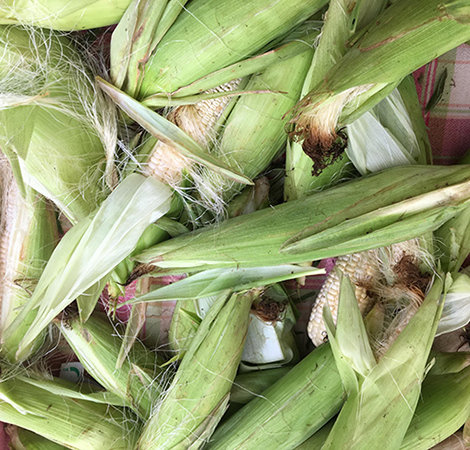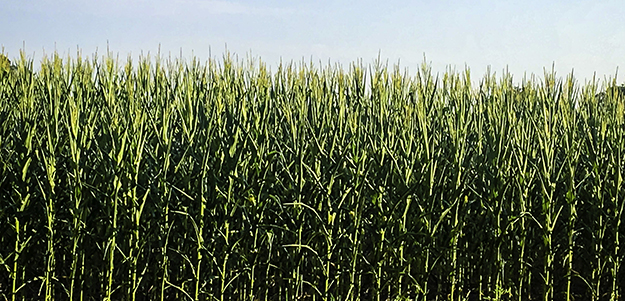
Photo by Bob Bowie.
Also known as maize, corn is an annual grass in the family Gramineae. Wheat, rye, barley, rice, sorghum, and sugarcane are other grasses in this family.
Corn was first domesticated by indigenous peoples in south-central Mexico about 10,000 years ago. It florishes in diverse climates, which rapidly extended its cultivation across the globe. Maize is the most widely grown grain crop throughout the Americas, with 361 million metric tons grown in the United States in 2014. Currently, corn leads wheat and rice in total grain production world-wide. There are six major types of maize: dent corn, flint corn, pod corn, popcorn, flour corn, and sweet corn.
Corn plants can grow to 10 feet tall. Its stem is usually composed of 20 nodes of just over 7 inches in length. Each node can have a leaf, which is between 4 inches in width and 4 feet in length. These leaves end in a tassel. When the tassel is mature and weather conditions are warm and dry, they release pollen. The end of the leaves have a hair-like, pale yellow silk which can be up to 7 inches long. If a pollen grain fertilizes an ear, a kernel (or seed) develops. Individual kernels are arranged in regular rows. While the most well-known colors of kernels are yellow or white, they can be blackish, bluish-gray, purple, green, or red.

Photo by Bob Bowie.
A successful corn crop depends on climate conditions. Its shallow roots make it susceptible to droughts, to produce poorly in soil which is either nutrient-deficient or lacks moisture, and to be uprooted by severe winds. It doesn’t do well in cold conditions, which is why here in Virginia it is planted in the spring.
Not only is corn relatively easy to grow, it is one of our most versatile crops
- “Sweet corn” is a food staple for people in a variety of forms: eating the kernels themselves, ground into flour or cornmeal, pressed into corn oil, fermentated and distilled into alcoholic beverages like bourbon and whiskey, turned into corn starch, and boiled into corn syrup.
- Feed for animals
- Fuel for vehicles as corn ethanol with approximately 40% of the crop (130 million tons in 2014) used for corn ethanol.
Beyond its central place in our agricultural system, why does corn leap to mind when I think about summer? The taste and smell as I dive into a shucked ear of hot corn dripping with butter and salt and knowing that there will be more ear than one to eat.
A light wind swept over the corn, and all nature laughed in the sunshine. by Anne Bronte
